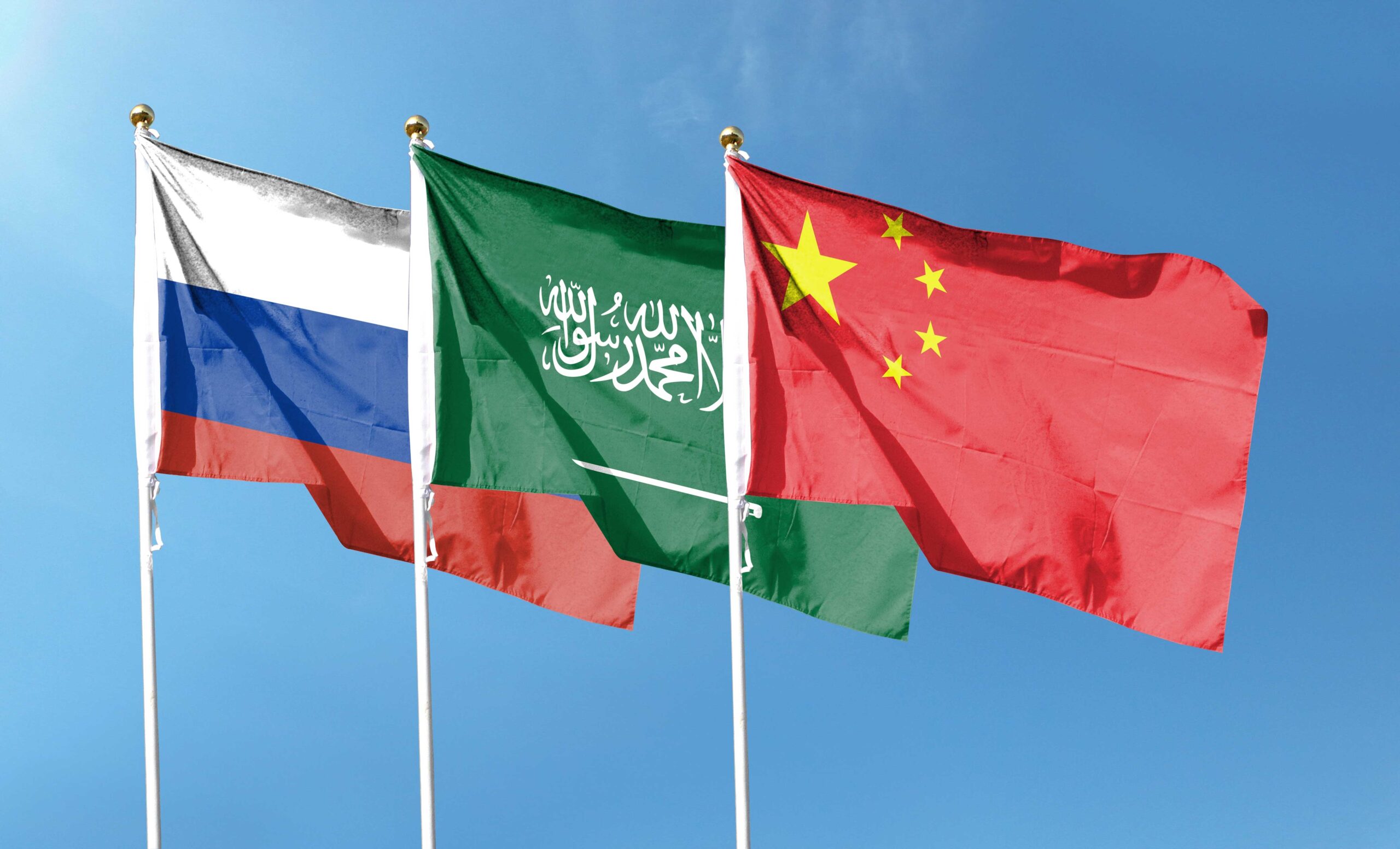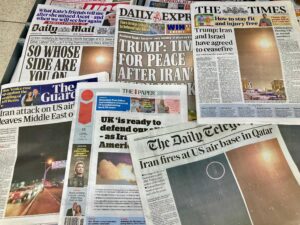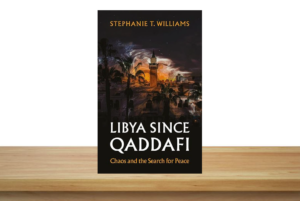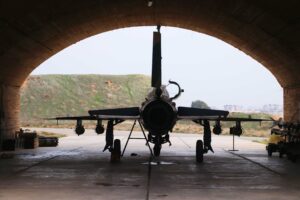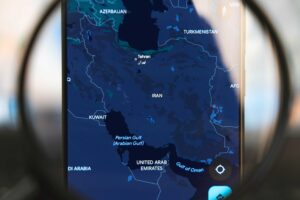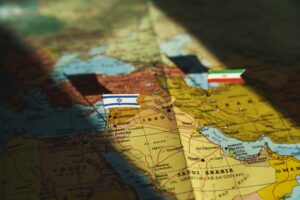Inviting Saudi Arabia and other regional states during the 15th BRICS summit in South Africa to a rising bloc pooling the global south and led by China is a historic moment. BRICS constitutes 31.6% of the world’s GDP, 26% of its mass area, and 42% of its population. Amid the US rivalry with China and Russia, BRICS+ challenges the long-lasting US-led global order.[1] Saudi Arabia, a steadfast US ally within this bloc, represents a significant component in reshaping the Middle East’s post-America order. In turn, this invitation reflects China and Russia’s aspirations to extend their economic and geopolitical influence into a resource-rich Global South that’s also a major arms-importing region. China and Russia are capitalizing on the void left by the United States in the Middle East, assuming the dual roles of equitable trade partners and trusted mediators in a shifting multipolar world order.
This shift is similar to the Cold War era in the region, albeit with critical differences. Communist China had no influence in the region while Soviet Russia was embroiled in conflicts with the West worldwide, including in the Middle East. Today, ideology takes a backseat, and instead, China and Russia present themselves as pragmatic Eurasian powers, leading the Global South in addressing economic and financial challenges, and often attributing such challenges to the West. In contrast to the Cold War-era Western-Arab alliances, primarily formed for security reasons, any alliance led by China in the region today aims to establish a new regional order based on cooperation and equal partnership.
Saudi Arabia's pivotal role in the region and the opportunities presented by current conditions have enticed China and Russia to draw Riyadh into their orbits.
Before Saudi Arabia was invited into BRICS and the Shanghai Cooperation Organization (SCO), China had already established comprehensive strategic partnerships with regional actors[2], engaging in strategic dialogues with Gulf Cooperation Council countries and actively participating as part of the China-Arab Cooperation Forum, among many other venues. In 2016, China outlined its vision for strengthening ties with Arab nations in the Arab Policy Paper and introduced the 2021 Five-Point Initiative[3] for peace efforts and conflict resolution. Russia, with its Soviet legacy in the region, maintains relations that extend beyond economics. While there are political differences, particularly concerning countries like Syria and Iran, Russian relations with the region have evolved since 2015, especially amid its confrontation with the West over the Ukraine conflict. Saudi Arabia’s pivotal role in the region and the opportunities presented by current conditions have enticed China and Russia to draw Riyadh into their orbits. This narrative unfolds as both nations observe Saudi Arabia’s shifting dynamics in its alliance with Washington as well as its ongoing domestic transformations in politics and economics alike. However, their challenge remains how to effectively engage Saudi Arabia, a staunch US ally, either through blocs like BRICS or through individual efforts, whether by hedging or wedging.
Hedging
Saudi Arabian Crown Prince Mohammed bin Salman (MbS) aims to establish the fourth kingdom of Saudi Arabia[4] through domestic modernization and the re-orientation of the Kingdom’s foreign policy. He believes that forging strong global partnerships and ensuring regional stability are essential for realizing his Vision 2030 plans. However, a brewing geopolitical cold war involving the West, Russia, and China in the region and beyond its borders adds uncertainty.
In this delicate context, Saudi Arabia needs a dual strategy, including hedging[5] and signaling. Hedging allows Saudi Arabia to navigate the risks and gains of the global rivalry between the US, China, and Russia, vying for its favor while signaling to the US the need for a change in its approach towards the Kingdom. The Saudis must align their economic and security interests with their largest trading partner, China, capitalizing on techno-scientific innovation[6], and simultaneously focus on energy production and prices with their energy partner, Russia, all the while engaging with the US on defense issues. These interests inspire a multi-dimensional Saudi foreign policy.[7]
First, Saudi Arabia seeks foreign policy autonomy and flexibility in its alliances through a position of relative neutrality. Unlike liberal values that shape alliances in the West, Saudi leaders find engaging with the Chinese and Russians smoother due to certain shared ideologies.[8] Recent strains in Saudi-US relations, stemming from issues like human rights, the Yemen war, and disputes over recognizing Israel, have prompted this shift.
Second, Saudi Arabia aims to shift from hierarchical partnerships, seen as trade-offs like the ‘oil-for-security’ paradigm with the West, to more equitable partnerships.[9] Saudi Arabia and the entire GCC have recently emphasized economic diversification and modernization, vital for their goals of developing megacities and localizing arms production and technological research. Recent shifts have brought the economic ambitions of China and Saudi Arabia closer to each other, converging between China’s Belt and Road Initiative (BRI)[10] and Saudi Arabia’s Vision 2030[11], both rooted in trade and intricate trade routes. China’s rapid economic growth positions it as a global model, offering an alternative narrative to non-democratic nations in the Global South.
Third, Saudi Arabia and its regional peers anticipate that Eastern powers like China and Russia will play a role in devising a strategy for lasting peace in the region after Western efforts have often fallen short. This stems from their trust in Asian wisdom, non-imperialist histories, and sharing values and perspectives of the global South.
Leveraging China and Russia’s global influence, especially their veto power in the UN Security Council, Saudi Arabia could address regional conflicts more effectively in international fora. This partnership, combined with its significant leadership role in the Sunni, broader Arab, and Gulf regions, would enhance its global standing.[12] China’s active pursuit of a role as promoter of global peace, as outlined in Xi Jinping’s Global Security Initiative (GSI)[13] and Wang Yi’s Five-point Initiative, has already facilitated a thaw in Saudi-Iranian relations.[14] If Riyadh breaks away from the West, it could lessen Iran’s justifiable hostility towards it, and Iran will assume that Riyadh is finally aligning with its long-expressed anti-imperialist sentiments. However, Saudi Arabia will assess Beijing’s ability and credibility to sustain this endeavor. Importantly, if China and Russia can ensure improved behavior regional and international from Iran, Saudi Arabia could potentially reduce its reliance on the United States for regional security. Institutionally, BRICS offers a unique opportunity to gather adversaries under a common flag, including Saudi Arabia and Iran.
In recent times, China often advocated for 'equitable partnerships' and 'trustworthiness,' underscoring its more advantageous reputational stance compared to the West in the Middle East.
Why China? While the United States once held a dominant position, acting as both a global powerhouse and the guardian of the Gulf, safeguarding the region from communist influence and protecting royal families, China was primarily viewed as a socialist state associated with lower-quality goods.[15] Consequently, Saudi-Sino relations remained cautious for three decades.[16] However, in recent times, China often advocated for ‘equitable partnerships’ and ‘trustworthiness,’ underscoring its more advantageous reputational stance compared to the West in the Middle East and steering clear of overt ideological influence, allowing flexibility for those who wish to collaborate with it. Finally, being conscious of the region’s cultural and political sensitivities, and operating within Washington’s sphere of influence, Beijing strategically employs hedging to strike a delicate balance.[17]
China is Saudi Arabia’s largest trading partner.[18] In 2022, their bilateral trade reached $106 billion, a 30% increase from the previous year. In contrast, the United States falls short in trade volume, making it Saudi Arabia’s second-largest trade partner. Saudi Arabia plays a pivotal role as one of China’s primary crude oil suppliers, satisfying about 19% of China’s energy needs. King Salman’s 2017 visit to China resulted in a substantial $65 billion Sino-Saudi trade and investment deal focused on energy and petrochemical investments, including agreements between Saudi Aramco and China North Industries Group Corporation for the construction of a refinery in China, as well as collaboration between Saudi Basic Industries Corporation and Sinopec for petrochemical product development.[19]
With Russia, Saudi Arabia has strengthened its diplomatic ties[20], particularly through close cooperation within OPEC+. Together, they represent 21% of global oil production. Additionally, they are exploring sectors beyond energy, such as in space exploration, nuclear power, and in the defense industry while also addressing regional challenges in light of Russia’s 2021 Collective Security Proposal for the Gulf region.[21] Strong Russian-Saudi relations would discourage Russia from leaning too heavily toward Iran and potentially forcing it to adopt a more balanced relationship with both parties. Similarly, any reconciliation between Iran and Saudi Arabia would solidify a shared Saudi-Russian perspective on various issues, including the situation in Syria. Saudi Arabia’s conciliatory stance toward the Syrian regime has the potential to facilitate conflict-resolution in Syria. This could effectively reduce Iran’s influence in the country while allowing the Syrian government to curb Captagon smuggling, which directly impacts the GCC states. Such a Syrian policy by Saudi Arabia might also lead to an ease in the responsibilities of Russia in Syria.
Wedging
Until the US decides to ensure Saudi deterrence through a treaty alliance, the Saudis will likely explore alternatives.
Driving a wedge between Riyadh and Washington is possible. This depends on how China and Russia align Saudis with their interests and capitalize on strained Saudi-US relations, reinforcing the impression of Saudi Arabia distancing itself from the US. The extent to which China and Russia can foster this rift also depends on future Saudi-US relations and Washington’s connections with Moscow and Beijing. But until the US decides to ensure Saudi deterrence through a treaty alliance, which is presently challenging and contentious[22], the Saudis will likely explore alternatives such as sharing with China and Russia some responsibility for regional security. Since the attacks on Saudi Aramco facilities in 2019, it is no longer solely the House of Saud’s need for regime security that we can speak of; but instead, it is the security of energy production.
Yet, China faces a unique alignment dilemma compared to Russia, as it typically draws allies into its orbit without providing explicit security assurances. Should China decide to challenge this customary approach, it would require a substantial foreign policy shift on its part. At this moment, the possibility of China engaging in arms deals with Saudi Arabia and providing defense technology is feasible. While the prospect of making defense commitments or establishing military bases in the region could imply a ‘wedging’ approach by China.[23] Also, such a Chinese shift may provoke the ire of the US and other European powers, such as France and the UK, who are unlikely to tolerate the Chinese military bases in the Gulf.
According to Vision 2030, Saudi Arabia would localize 50 percent of defense requirements in the coming years.[24] China and Russia present attractive support for achieving this goal. Nevertheless, Saudi Arabia is expected to persist in procuring arms from Western suppliers due to their high quality and as a sign of commitment to enduring partnerships. In the 1980s, Saudi Arabia engaged in arms deals with China[25], acquiring 50 DF-3/CSS-2 medium-range ballistic missiles in 1986. Subsequent agreements encompassed the procurement of 54 PLZ-45 self-propelled guns and the purchase of CH-4 and Wing Loong-1 armed drones between 2014 and 2017. The CH-4 drones, closely resembling the US-made MQ-1 Predator and tested during the Yemen war, held particular significance for Saudi Arabia. As part of Saudi Arabia’s efforts to promote and localize its domestic arms industry, an agreement was reached in 2017 with China to establish a drone manufacturing facility within the kingdom.[26] In December 2021, a CNN report unveiled collaborative efforts between Beijing and Riyadh in developing a domestic ballistic missile system.[27] This enduring Saudi interest in Chinese arms, notably drones, was underscored during the 2022 Zhuhai Air Show, culminating in total arms acquisitions valued at $4 billion.[28]
A turning point in Russian-Saudi relations could be Saudi Arabia’s procurement of the Russian S-400 air defense systems, posing challenges for the United States. President Putin once remarked, “If Saudi Arabia wants to protect itself, it should make a wise state decision as Iran did buying S-300 and Turkey buying S-400 air-defense systems, which can securely protect all infrastructural objects in the kingdom.”[29] Saudi Arabia’s intention to engage with Russia in arms deals was evident during visits by Saudi Crown Prince MbS and King Salman bin Abdulaziz to Moscow in 2017.[30] King Salman bin Abdulaziz was the first Saudi king to visit Moscow. These visits significantly strengthened bilateral ties. Saudi Arabia agreed to purchase the S-400 Triumf[31], the most advanced Russian long-range air defense missile system, making it the second country in the region, after Turkey, to deploy such advanced technology. Also, the Saudi Arabian Military Industries SAMI signed a MoU with the Russian state-owned arms exporter Rosoboronexport company that would localize and sustain the manufacture of advanced weapons in the Kingdom[32], including the transfer of manufacturing technology like Kornet-EM, TOS-1A, and AGS-30 systems.
US Reaction Scenarios
US structural and presidential priorities shifted, impacting the once-strong Saudi-US relations.
During the 1980s amidst the intense global rivalry of the Cold War, Saudi-US relations were guided by the Carter Doctrine, which focused on safeguarding the Gulf from communism. This later turned into a protection from Iraqi Ba’athism in the 1990s. With the emergence of a new threat—Iran’s regional infiltration and terrorism—US structural and presidential priorities shifted, impacting the once-strong Saudi-US relations. For the past three administrations, each US president has contributed uniquely to a new status quo. This ranged from Obama’s pivot to the East and support for Arab Spring uprisings, and the Iran nuclear deal, through Trump’s lax response to the 2019 attack on the Abqaiq processing plant and the Khurais oilfield, to, Biden’s initial approach to treat the kingdom as a pariah state.[33]
The Saudis face disappointments in their relationship with the US, critical threats from Iran and its Yemeni Houthi proxies, and also nurture important projects aligned with their 2030 Vision. As a result, they are poised to act. As perceptive Saudi journalist Abdulrahman Al-Rashed aptly notes, “Saudi Arabia today is not the Saudi Arabia of five years ago, nor is the US today the same US it was yesterday.”[34] So, what steps can they take? Two things. First, tactically maneuvering to seek trade and security allies—China and Russia—while expecting strategic self-reassessment and concessions from the US. This confirms what MbS said: “By playing major powers against each other, Saudi Arabia can eventually pressure Washington to concede to its demands for better access to US weapons and nuclear technology.”[35] Second, adopting a more assertive approach by not aligning with US interests unconditionally. The Saudis resist taking a clear Western stance against Putin’s war in Ukraine, in cooperation with their OPEC+ partners, they also declined to increase oil output, partly to impact the Russian economy, and they also maintain hard conditions on normalizing their ties with Israel.[36]
The American approach to managing its ties with Saudi Arabia encompasses two scenarios. The first is about setting red lines and selectively ignoring Saudi interests. The United States will likely draw a red line for Saudi Arabia, especially concerning its growing ties with China and Russia, particularly in the security realm. Complicating and rejecting Saudi demands for arms deals, which have intensified since the Yemen war, are central to this approach. Recent events, such as the reported collapse of a substantial arms deal between the US company RTX and a Saudi arms firm, as unveiled in the Wall Street Journal, underscore this stance.[37] Additionally, this might reopen controversial human rights matters in Saudi Arabia and possibly sideline peace efforts in Yemen, emboldening the Houthi rebels to carry out further attacks on critical targets within Saudi Arabia. The second scenario in US-Saudi ties concerns the reevaluation of bilateral relations and concessions. This strategy calls for both partners to negotiate and pinpoint differences and shortcomings in their bilateral ties, aiming to reach a consensus on shared objectives. Such an approach is outlined in the Jeddah Communique of July 2022[38], drafted during President Biden’s visit to Saudi Arabia. Initially, it entailed reconsidering the ‘US pivot away from the Middle East,’[39] and focusing on strengthening military presence in the region again. The recent deployment of over 3,000 US troops and guided missile destroyers in response to perceived threats from Iran and Russia underscores this commitment.[40] This deployment aims to reinforce the US military presence in the region, which has significantly declined, reaching 85% less than its peak in 2008. Furthermore, both nations recently conducted the largest Red Sands joint military drill on anti-Unmanned Aircraft Systems (UAS) in the region[41], highlighting collaborative efforts to enhance their security partnership. Another possible path to a more robust security partnership between the US and Saudi Arabia is designating Saudi Arabia as a Major Defense Partner (MDP) or a Major Non-NATO Ally (MNNA).[42] These designations offer certain benefits in defense trade and security cooperation without entailing security commitments to the designated country. Lastly, the United States can assist in developing a much-needed Saudi civilian nuclear program[43] without imposing conditions that Riyadh finds unreasonable and overly intertwined with the normalization of ties with Israel.
Conclusion
The recent Hamas-Israel war, which erupted on October 7, represents a significant development in the ongoing transformation of the political and security dynamics in the Middle East, which have been underway since the Iraq War and the Arab Spring uprisings. These changes will have far-reaching effects on both the regional and global landscapes, with China and Russia taking on significant roles as they engage with the West on multiple fronts, coinciding with a rising regional resentment of the Western (and particularly US) stance towards Israel. In China and Russia, this conflict is viewed as a direct result of the United States’ decades-long inability to find a peace formula for the Palestinian-Israeli conflict. Currently, Beijing and Moscow are likely to position themselves as mediators and promotors of peace. Finally, in contrast to the prevailing narrative suggesting that the United States is disengaging from the region, it has, in fact, reaffirmed its presence with unprecedented support for Israel since the beginning of the war. This prompts a question regarding how China and Russia will react to this swift change in American policy in the Middle East. It also sparks speculation about the incentives the two powers can offer the region, in the context of the ongoing conflict as well as in terms of the region’s long-term development.
[1] Global Memo, (2023). ‘The BRICS Summit 2023: Seeking an Alternate World Order?’, Council on Foreign Relations, 31 August 2023, retrieved from The BRICS Summit 2023: Seeking an Alternate World Order? | Council of Councils (cfr.org).
[2] Eslami, M. and Papageorgou, M., (2023). ’China’s Increasing Role in the Middle East: Implications for Regional and International Dynamics’, Georgetown Journal of International Affairs, 2 June 2023, retrieved from China’s Increasing Role in the Middle East: Implications for Regional and International Dynamics – Georgetown Journal of International Affairs.
[3] Ministry of Foreign Affairs of the People’s Republic of China, (2021). ’Wang Yi Proposes a Five-point Initiative on Achieving Security and Stability in the Middle East’, 26 March 2021, retrieved from Wang Yi Proposes a Five-point Initiative on Achieving Security and Stability in the Middle East (fmprc.gov.cn).
[4] Harb, I.K., (2020). ’The Fourth Saudi State Remains a Distant Vision’, Arab Center Washington DC, 3 April 2020, retreived from The Fourth Saudi State Remains a Distant Vision (arabcenterdc.org).
[5] Jamal, U., (2023). ‘Analysis: What do BRICS invitations mean for the Middle East?’, Aljazeera, 25 August 2023, retrieved from Analysis: What do BRICS invitations mean for the Middle East? | Politics News | Al Jazeera.
[6] Al-Sudairi, M., Hai, S.J. and Alahmad, K., (2023). ’How Saudi Arabia Bent China to Its Technoscientific Ambitions’, Carnegie Endowment for International Peace, 1 August 2023, retrieved from How Saudi Arabia Bent China to Its Technoscientific Ambitions – Carnegie Endowment for International Peace.
[7] Kalin, S. and Said S., (2023). ’Saudi Crown Prince Test Drives Nonaligned Foreign Policy’, The Wall Street Journal, 14 March 2023, retrieved from Saudi Crown Prince Test Drives Nonaligned Foreign Policy – WSJ.
[8] Porter, T., (2023). ’How Saudi Arabia’s crown prince snubbed Biden repeatedly to forge ties with authoritarian China and Russia’, Insider, 1 January 2023, retrieved from Saudi Arabia Snubs US, Embraces China and Russia in Global Power Play (businessinsider.com).
[9] Saab, B.Y., (2023). ‘After Oil-for-Security: A Blueprint for Resetting US-Saudi Security Relations’, Middle East Institute, 17 February 2023, retrieved from After Oil-for-Security: A Blueprint for Resetting US-Saudi Security Relations | Middle East Institute (mei.edu).
[10] Yu, J. and Wallce, J., (2021). ’What is China’s Belt and Road Initiative (BRI)?’, Chatham House, 13 September 2021, retrieved from What is China’s Belt and Road Initiative (BRI)? | Chatham House – International Affairs Think Tank.
[11] Vision 2030.gov.sa, (2023). ‘Saudi Vision 2030’, retrieved from Saudi Vision 2030 –.
[12] Jacobs, A., (2023). ‘Understanding Saudi Arabia’s Recalibrated Foreign Policy’, International Crisis Group, 14 September 2023, retrieved from Understanding Saudi Arabia’s Recalibrated Foreign Policy | Crisis Group.
[13] Boa Forum for Asia, (2022). ’The World in Covid-19 & Beyond: Working Together for Global Development and Shared Future’, 22 April 2022, retrieved from Boao Forum for Asia Annual Conference 2022.
[14] Jash, A., (2023). ‘Saudi-Iran Deal: A Test Case of China’s Role as an International Mediator’, Georgetown Journal of International Affairs, 23 June 2023, retrieved from Saudi-Iran Deal: A Test Case of China’s Role as an International Mediator – Georgetown Journal of International Affairs.
[15] Jallo, A., (2023). ‘China and the Arab World: From the Silent Partner to Center Stage’, Wilson Center, 17 August 2023, retrieved from China and the Arab World: From the Silent Partner to Center Stage | Wilson Center.
[16] Fulton, J., (2020). ’Strangers to Strategic Partners: Thirty Years of Sino-Saudi Relations’, Atlantic Council, August 2020, retrieved from Sino-Saudi-Relations_WEB.pdf (atlanticcouncil.org).
[17] Fulton, J., (2020). ’China in the Persian Gulf: Hedging under the US umbrella’, 14 April 2020, retrieved from China-and-the-Persian-Gulf-Hedging-Under-the-US-Umbrella.pdf (researchgate.net).
Observatory of Economic Complexity, (2023). ‘China-Saudi Arabia’, October 2023, retrieved from China (CHN) and Saudi Arabia (SAU) Trade | OEC – The Observatory of Economic Complexity.
[18] Observatory of Economic Complexity, (2023). ‘China-Saudi Arabia’, October 2023, retrieved from China (CHN) and Saudi Arabia (SAU) Trade | OEC – The Observatory of Economic Complexity.
[19] Tanchum, M., (2017). ’Saudi Arabia the next stop on China’s Maritime Silk Road’, East Asia Forum, 22 March 2017, retrieved from Saudi Arabia the next stop on China’s Maritime Silk Road | East Asia Forum.
[20] Ulrichsen, K.C., Finley, M. and Krane, J., (2022). ’The OPEC+ Phenomenon of Saudi-Russian Cooperation and Implications for US-Saudi Relations’, Baker Institute, 18 October 2022, retrieved from The OPEC+ Phenomenon of Saudi-Russian Cooperation and Implications for US-Saudi Relations | Baker Institute.
[21] The Ministry of Foreign Affairs of the Russian Federation, (2021). ’Russia’s Collective Security Concept for the Persian Gulf’, 24 August 2021, retrieved from Russia’s Collective Security Concept for the Persian Gulf – The Ministry of Foreign Affairs of the Russian Federation (mid.ru).
[22] Saab, B., (2023). ’The costs and benefits of Saudi-Israeli normalisation’, Al Majalla, 14 September 2023, retrieved from The costs and benefits of Saudi-Israeli normalisation | Al Majalla.
[23] Fulton, J., (2022). ‘China is trying t create a wedge between the US and Gulf allies, Washington should take note.’ Atlantic Council, 27 January 2022, retrieved from China is trying to create a wedge between the US and Gulf allies. Washington should take note. – Atlantic Council.
[24] Radwan, R., (2023). ’How Saudi Arabia’s SAMI is driving the localization of the Kingdom’s defense industry’, Arab News, 20 August 2023, retrieved from How Saudi Arabia’s SAMI is driving the localization of the Kingdom’s defense industry (arabnews.com).
[25] Xie, K., (2022). ’Why is Saudi Arabia looking to China to buy weapons after years of arms deals with the US?’, South China Morning Post, 8 December 2022, retrieved from Why is Saudi Arabia looking to China to buy weapons after years of arms deals with the US? | South China Morning Post (scmp.com).
[26] Chan, M., (2017). ’Chinese drone factory in Saudi Arabia first in Middle East’, South China Morning Post¸26 March 2017, retrieved from Chinese drone factory in Saudi Arabia first in Middle East | South China Morning Post (scmp.com).
[27] Cohen, Z., (2021). ’CNN Exclusive: US intel and satellite images show Saudi Arabia is now building its own ballistic missiles with help of China’, CNN, 23 December 2021, retrieved from CNN Exclusive: US intel and satellite images show Saudi Arabia is now building its own ballistic missiles with help of China | CNN Politics.
[28] Szuba, J., (2022). ‘As US watches China and Saudi Arabia shy away from defense deals during Xi’s visit’, Al-Monitor, 11 December 2022, retrieved from As US watches, China and Saudi Arabia shy away from defense deals during Xi’s visit – Al-Monitor: Independent, trusted coverage of the Middle East.
[29] Khlebnikov, A., (2019). ’What does the Saudi oil facility attack mean for Russia?’, Middle East Institute, 24 September 2019, retrieved from What does the Saudi oil facility attack mean for Russia? | Middle East Institute (mei.edu).
[30] Wintour, P., (2017). ‘Saudi king’s visit to Russia heralds shift in global power structures’, The Guardian, 5 October 2017, retrieved from Saudi king’s visit to Russia heralds shift in global power structures | Saudi Arabia | The Guardian.
[31] Mustafa, A., (2020). ‘Saudi Arabia agrees deal for Russian S400 missile defense systems’, Alarabiya News, 20 May 2020, retrieved from Saudi Arabia agrees deal for Russian S400 missile defense systems | Al Arabiya English.
[32] Reuters, (2017). ‘Saudi Arabia agrees to buy Russian S-400 air defense system: Arabiya TV’, Reuters, 5 October 2017, retrieved from Saudi Arabia agrees to buy Russian S-400 air defense system: Arabiya TV | Reuters.
[33] Emmons, A., Chavez, A. and Lacy, A., (2019). ’Joe Biden, in departure from Obama policy, says he would make Saudi Arabia a pariah’, The Intercept, 21 November 2019, retrieved from At Debate, Joe Biden Casts Saudi Arabia as “Pariah” (theintercept.com).
[34] Al-Rashed, A., (2023). ‘Are We Nearing the End of Saudi-US Dispute?’, Asharq Al-Awsat, 12 March 2023, retrieved from Are We Nearing the End of Saudi-US Dispute? (aawsat.com).
[35] Kalin, S. and Said, S., (2023). ’Saudi Crown Prince Test Drives Nonaligned Foreign Policy’, The Wall Street Journal, 14 March 2023, retrieved from Saudi Crown Prince Test Drives Nonaligned Foreign Policy – WSJ.
[36] Liptak, K., (2023). ‘Saudi Arabia looks for security assurances from US as conditions for normalizing ties with Israel’, CNN, 10 March 2023, Saudi Arabia looks for security assurances from US as condition for normalizing ties with Israel | CNN.
[37] Kalin, S., (2023). ‘Arms Megadeal Collapsed When China, Russia Links Emerged’, The Wall Street Journal, 15 September 2023, retrieved from Arms Megadeal Collapsed When China, Russia Links Emerged – WSJ.
[38] White House, (2022). ’The Jeddah Communique: A Joint Statement Between the United States of America and the Kingdom of Saudi Arabia’, 15 July 2022, retrieved from The Jeddah Communique: A Joint Statement Between the United States of America and the Kingdom of Saudi Arabia | The White House.
[39] Arab Center Washington DC, (2023). ‘A US Pivot Away from the Middle East: Fact or Fiction’, May 2023, retrieved from A US Pivot Away from the Middle East: Fact or Fiction? – Arab Center Washington DC (arabcenterdc.org).
[40] Aftandlian, G., (2023). ‘US Troop Buildup in the Gulf Reemphasizes Military Power’, Arab Center Washington DC, 15 August 2023, retrieved from US Troop Buildup in the Gulf Reemphasizes Military Power (arabcenterdc.org).
[41] Szuba, J., (2023). ‘Pentagon expands counter-drone exercise with Saudi Arabia, eyeing Iran threat’, Al-Monitor, 19 September 2023, retrieved from Pentagon expands counter-drone exercise with Saudi Arabia, eyeing Iran threat – Al-Monitor: Independent, trusted coverage of the Middle East.
[42] Bowman, B., Kittrie, O. and Brobst, R., (2023). ‘The United States and Saudi Arabia: A Possible Path Forward’, Foundation for Defense of Democracies, 28 April 2023, retrieved from The United States and Saudi Arabia: A Possible Path Forward (fdd.org).
[43] Nissenbaum, D., Lieber, D. and Kalin, S., (2023). ’Saudi Arabia Seeks U.S. Security Pledges, Nuclear Help for Peace with Israel’, The Wall Street Journal, 9 March 2023, retrieved from Saudi Arabia Seeks U.S. Security Pledges, Nuclear Help for Peace With Israel – WSJ.


